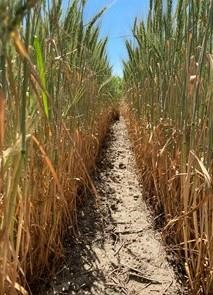By Jared Goplen and Jochum Wiersma et.al
The unprecedented hot and dry weather in the upper Midwest has continued to deteriorate large acreages of the small grains. In some cases, grain yield potential has declined to a point where it may make more sense to harvest the small grains as forage rather than waiting to harvest as grain. Reports of chopping small grains for forages have already come in from dry areas of the state.

Crop Insurance and RMA
Before doing anything, begin having conversations with your crop insurance provider. There are provisions related to harvesting drought-stressed crops as forages. To ensure crop insurance payments, you need to provide a notice of loss to your insurance provider and get those acres released. For additional information contact your crop insurance agent.
Visit USDA’s Risk Management Agency for more information.
Small Grains make Excellent Forage
Small grain hay and silage can make excellent forage. Forage supplies will tighten if the drought conditions persist. The forage quality of small grains is largely determined by the growth stage when small grains are harvested. If your primary objective is tonnage, waiting to harvest small grains until the dough stage will maximize yield, but will sacrifice forage quality. The heat and dry conditions have sped small grains along, meaning many are at or beyond the boot stage already. Quality will continue to go down as the small grains mature. If small grains are severely drought-stressed and withering away, additional biomass will not accumulate without additional moisture. Drought will likely not have a substantial impact on forage quality compared to conditions with adequate soil moisture.
Forage samples should be collected from all harvested forage to test for forage quality. Measuring forage quality contains additional information.
Check for Nitrates!
The primary concern with harvesting drought-stressed small grains as forage is excessive accumulation of nitrate. This can lead to nitrate poisoning without proper care. When submitting forage quality samples, be sure to have samples tested for nitrate concentrations.
Nitrate poisoning in cattle, sheep and goats has information on collecting forage samples, interpreting nitrate sample analysis results and minimizing nitrate problems.
Harvesting
As drought conditions intensify, the lower leaves on small grains will dry out, which increases leaf loss potential when harvesting as forage. Cutting and harvesting small grains prior to excessive leaf loss will improve yield and quality. However, small grains will likely have lower nitrate concentrations as the plants mature.
Chopping Silage
Chopping small grains at 60 – 70% moisture is best to make good silage. In drought-stressed situations, the moisture content may already be below this level, meaning direct chopping will likely be best. If the moisture content is still 70% or greater, allow wilting time to decrease the moisture content. The hollow stems in small grains do cause some challenges in eliminating oxygen. Using a shorter cut length of 3/8 – 1/2 inch will assist with packing. Whether piling or bagging, insufficient packing will result in greater storage losses. Allow a fermentation period of at least 21 days before feeding. Another benefit of ensiling is it can reduce nitrates by 30-70%, meaning ensiling is the preferred harvest method for crops with concerns about high nitrate levels.
Making Hay
Especially if nitrates are not a concern, small grains can be made into dry hay. More mature small grains can be deceivingly dry in some cases due to moisture present in developing heads, which can take more time to dry compared to moisture in the stem. Ensure baled small grains are indeed dry enough, especially before storing inside buildings to prevent hay fires. Using a conditioner can aid in dry down. If the crop is later in maturity, conditioners may increase shattering losses, however.
An alternative to making dry hay is making baleage, which works well for storing small grain forage. Regardless of the moisture content hay is harvested at, ensure enough wrap is used (at least 6 mils), which typically means 7-8 wraps when accounting for the stretch of the plastic film.
Feeding Forages High in Nitrates
Drought-stressed small grain forages should be tested for nitrate concentration before feeding. Forages high in nitrates can be fed when diluted with other feedstuffs (i.e. concentrates or forages) low in nitrates. Ruminant animals can consume small amounts of high-nitrate feeds and gradually adapt to increasing amounts of high-nitrate forages over time. With hay, the best way to blend low- and high-nitrate forages is with grinding. If grinding is not possible, distribute the low-nitrate hay first, allowing the ruminant animals to consume most of the low-nitrate hay. Then distribute the high-nitrate hay. Prevent animals from consuming high-nitrate forages when they are hungry. Slow intake of high-nitrate feeds is the goal. If possible, feed high-nitrate forages in smaller amounts several times daily instead of one large daily feeding. Always provide livestock access to fresh, nitrate-free water at all times.
Feeding forages high in nitrates does have inherent risks but can be done safely. Nitrate poisoning of livestock provides guidelines on how to manage and feed forages high in nitrates.
Source : umn.edu